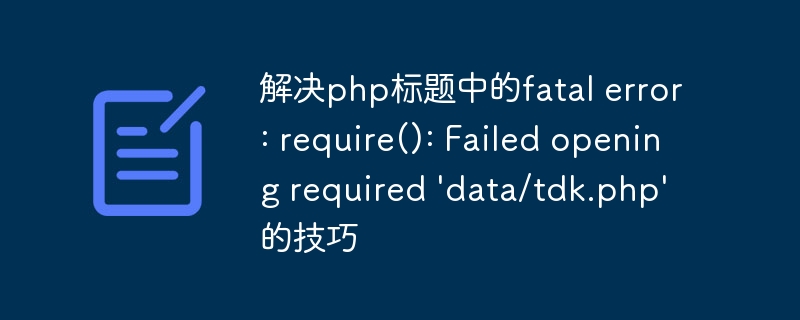

In PHP development, we often encounter this error message: fatal error: require(): Failed opening required 'data/tdk.php'. This error is usually related to file processing in PHP applications. The specific reasons may be incorrect file paths, non-existent files, or insufficient file permissions.
In this article, we will introduce you to some tips to solve such error prompts.
If the error message "fatal error: require(): Failed opening required" appears, you first need to check the file path used in the relevant code is it right or not. In PHP, file paths are usually relative to the current PHP script.
For example, if the current script is located in the "/var/www/html" directory and the required file "data/tdk.php" is located in the "/var/www/html/data" directory, it is correct The file path should be: "data/tdk.php".
It should be noted that different operating systems may have different specifications for file paths. For example, Windows uses "" to represent the path separator, while Unix/Linux uses "/". Therefore, when writing PHP code, you need to use path separators correctly according to the actual situation.
If the file path used is correct, but the "Failed opening required" error message still appears, then the file may not exist Caused by.
At this point, you need to check whether the required file exists in the specified path. If the file does not exist, it needs to be repaired according to the actual situation. If the file does not exist, you may need to rewrite the relevant code or create the file.
In some cases, the "Failed opening required" error message may occur due to file permission issues.
If a PHP application needs to access certain files or folders, the permissions of these files or folders must have sufficient permissions to be accessed. This error may appear if the permissions on the file or folder are not set correctly.
In Linux/Unix systems, you can use the following command to view the permissions of a file or folder:
ls -l <文件或文件夹路径>
In the results output by the command, "r" means readable and "w" means Writable, "x" means executable. The three characters in each group (such as "rwxr-xr-x") respectively represent the permissions of the file owner, the group to which the file belongs, and other users.
If you need to modify the permissions of a file or folder, you can use the following command:
chmod <权限设置> <文件或文件夹路径>
The "permission setting" usually consists of three octal numbers, which respectively represent the file owner and the group to which the file belongs. and other users' permissions. For example, "755" means that the file owner has read, write, and execute permissions, and the file's group and other users have read and execute permissions.
Finally, if the above method cannot solve the "Failed opening required" error message, you can try to use absolute paths. Compared with relative paths, absolute paths are not affected by the directory where the PHP script is located, and can access files more stably.
In PHP, you can use the following code to get the absolute path of the current file:
$path = dirname(__FILE__);
After getting the absolute path of the file, you can directly use the path to access the required file, for example:
require_once($path . "/data/tdk.php");
Summary
Through the above techniques, we can effectively solve the error message of "fatal error: require(): Failed opening required". It should be noted that in actual applications, the above methods need to be used comprehensively according to the specific situation to find the most suitable solution. At the same time, in order to avoid the occurrence of this error, it is recommended to carefully check the file path and file permissions when writing PHP code to ensure that the PHP application can correctly access the required files.
The above is the detailed content of Tips to solve fatal error in php header: require(): Failed opening required 'data/tdk.php'. For more information, please follow other related articles on the PHP Chinese website!